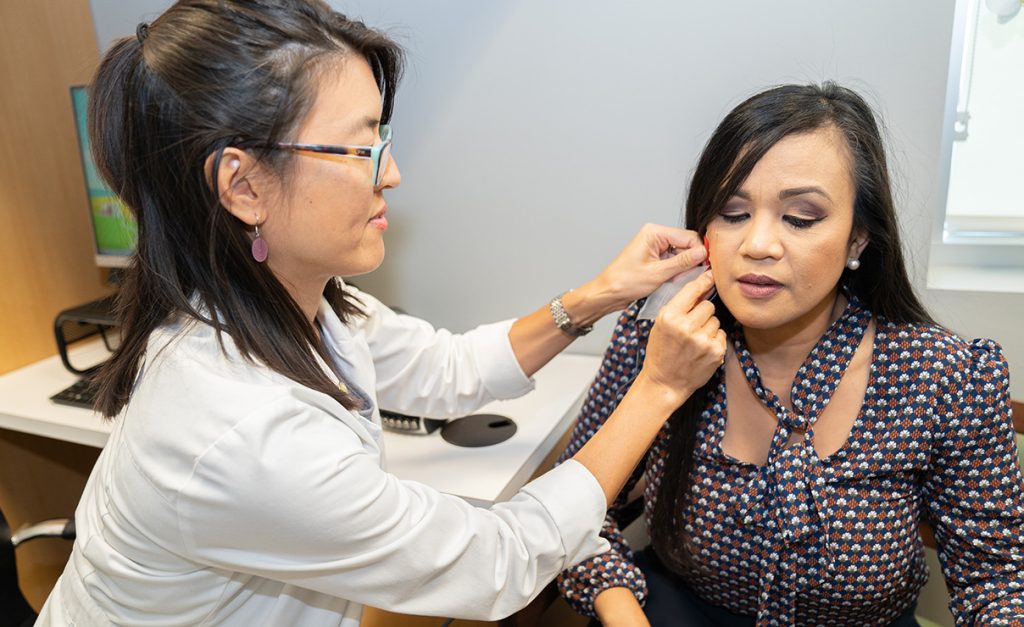Biofeedback measures physiological reactions—such as heart rate, muscle tension, or body temperature–that may reflect a stress response, providing immediate feedback that helps a patient learn how to control the negative effects of stress.
Non-invasive sensors are attached to the body, allowing patient and clinician to view these physiologic markers in real time. While observing feedback on a monitor, the patient uses exercises and relaxation techniques to control the nervous system. This can help calm the mind, relax muscles, reduce pain and improve overall wellness.

Overview
From taking a step to typing on a computer, you control many of your body’s physical movements. Some body functions, however, are less voluntary and can be negatively affected by stress. Your blood pressure and heart rate are examples. Because there is a strong relationship between mind and body, biofeedback can teach you how to manipulate some of these functions to give you more control over your body’s response to stress.
Principles
Biofeedback is a non-invasive procedure that utilizes sensors attached to the body to measure physiologic markers for such functions as heart rate, breath, muscle tension, skin temperature and sweat.
During a biofeedback session, the patient views real-time information from these sensors, learning to use exercises and relaxation techniques to obtain a response from the sensors that indicates the nervous system is gaining more balance. Many of the techniques involve altering breathing patterns, as well as increasing body awareness. These learned skills can help calm the mind, relax muscles, reduce pain, and improve overall wellness.
Conditions Treated
Biofeedback may be utilized to help manage such physical and mental health issues as:
- Anxiety, stress or moods
- Chronic pain
- Headache
- High blood pressure
- Irritable bowel syndrome
- Sleep issues
Services
During the initial integrative biofeedback consult, your provider considers many factors that can play a role in stress response — including nutrition, lifestyle, sleep, epigenetics and endocrine health — to determine which biofeedback method will most effectively address your issues and if additional approaches are needed. He or she may recommend one or more of the following biofeedback methods, offered by the Samueli Institute, to help you achieve your goals:
- electromyography (EMG) biofeedback, which measures muscle tension
- thermal or temperature biofeedback, which measures body temperature
- electroencephalography (EEG), sometimes referred to as neurofeedback, which measures brain wave activity
- galvanic skin response training, which measures the amount of sweat on your body
- heart variability biofeedback, which measures your pulse and heart rate
Why Choose Us?
As part of the only academic medical center in Orange County, our whole-health providers work together, under the guidance of a board-certified biofeedback professional, to develop treatment plans utilizing evidence-informed modalities that address your specific needs and help you achieve your goals for a healthy and balanced life.
Our Team

Associate Clinical Professor Department of Medicine |


Price
Susan Samueli Integrative Health Institute accepts a variety of insurance plans or private pay. Your visit may be subject to copay and deductible. Please contact us at 949-824-7000 for more information.
Research
- Cernes R, Zimlichman R. RESPeRATE: The role of paced breathing in hypertension treatment. J Am Soc Hypertens. 2015;9(1):38-47. doi:10.1016/j.jash.2014.10.002
- Goessl VC, Curtiss JE, Hofmann SG. The effect of heart rate variability biofeedback training on stress and anxiety : a meta-analysis. 2017:2578-2586. doi:10.1017/S0033291717001003
- Nestoriuc Y, Martin A. Efficacy of biofeedback for migraine: A meta-analysis. Pain. 2007;128(1-2):111-127. doi:10.1016/j.pain.2006.09.007
- Steffen PR, Austin T, DeBarros A, Brown T. The Impact of Resonance Frequency Breathing on Measures of Heart Rate Variability, Blood Pressure, and Mood. Front Public Heal. 2017;5(August):6-11. doi:10.3389/fpubh.2017.00222
- Zaccaro A, Piarulli A, Laurino M, et al. How Breath-Control Can Change Your Life: A Systematic Review on Psycho-Physiological Correlates of Slow Breathing. Front Hum Neurosci. 2018;12(September):1-16. doi:10.3389/fnhum.2018.00353
- Biofeedback: Types, Purpose, and Risks (healthline.com).
